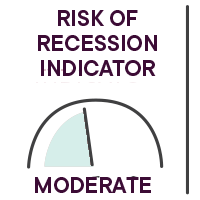Yann Furic
B.B.A., M. Sc., CFA®
Senior Portfolio Manager, Asset Allocation and Alternative Strategies
Inflation: temporary or sustained rise?
The rise in the Consumer Price Index and the Producer Price Index in the United States came as a big surprise, exceeding expectations and even outpacing inflation indicators.
The rapid improvement in the U.S. economy since the start of the year seems to favour inflation above 2%, as the markets anticipate higher inflation in the short term than in the long term.
Focus on the past month

Overview of global equity markets*
- The flagship index of the Canadian stock market, the S&P/TSX, advanced 3.4% in May.
- In the United States, the S&P 500 lost 1.0% and the Nasdaq, 3.0%.
- International stock markets were also in positive territory during the month, with the EAFE index up 1.97%.
- Emerging market equities fell 0.5% in May, while Chinese stocks were off 2.3%.
* All the percentages in this section are in Canadian dollars. Bloomberg unless otherwise indicated.
Key events
Inflation: the Fed maintains its position
For the Fed, May’s inflationary surge is transitory. The central bank confirmed its 2% target and said its conditions of full employment, a stable recovery and above-target inflation would have to be met before considering a revision of its current monetary policy.
Since prices fell in 2020 and global supply chains are still catching up, the Fed maintains its perception that these spikes in inflation will gradually dissipate as a degree of economic normalcy is restored.
Given the strong recovery in the United States, however, some members of the Fed warned at the last meeting in April that a reduction in liquidity will have to be discussed sooner than expected.
Meanwhile, the Canadian Consumer Price Index rose 3.4% year over year, beating expectations of a 3.2% increase. The question remains whether the recent inflationary trend is a transitory or sustained phenomenon. The reaction of the Canadian and U.S. bond markets appears to be leaning towards the Fed, as yields have moved little, remaining within a narrow range for almost two months now.
The ups and downs of cryptocurrencies
After a few strong months, cryptocurrencies were hit hard in May when various Chinese authorities reiterated that their financial institutions would not accept anonymous payment methods. For its part, the U.S. Treasury is considering the possibility that any transaction of $10,000 or more be reported to the tax authorities.
COVID-19 and vaccination campaigns
Overall, campaigns are well underway, but immunization coverage differs from country to country, limiting a synchronized global economic recovery.
Corporate earnings
U.S. earnings forecasts were revised upwards, which is positive for the markets.
Improved retail sales
March retail sales in Canada were up 3.6%, versus expectations of a 2.3% increase, while February’s retail sales gain was revised upwards from 4.8% to 5.8%.
Financial sector recovery
Canadian bank profits turned out to be higher than expected. After an extended hiatus, banks are awaiting regulatory authorization to raise dividends and initiate share buybacks. The Office of the Superintendent of Financial Institutions (OSFI) could give the green light during the third quarter of 2021.
Employment situation
In the United States, job creation disappointed again in May with 559,000 new jobs, falling short of the forecast of 675,000. As labour force participation fell, the unemployment rate decreased from 6.1% to 5.8%.
In Canada, 68,000 jobs were lost, exceeding the expected 25,000 job losses. The partial return to lockdown of several Canadian provinces explains this decline in employment, which should be temporary; the situation will likely improve as more and more of the population gets vaccinated. The unemployment rate was 8.2%, up 0.1%, as the labour force participation rate fell to 64.6% from 64.9% in April and 65.2% in March.
Results – Canadian bonds
Government of Canada bonds across maturities posted a positive return of 0.3% for the month. (Source: Canaccord Genuity)
Performance of our funds
View the returns

Our strategic monitoring
Main risks
Here are some risks that we are closely monitoring in the current environment.
- The cyclical recovery could be limited or delayed by various vaccine production problems or by a variant that does not respond to vaccination.
- A large-scale cyberattack could undermine the prevailing positive sentiment regarding the reopening of the global economy and consumer confidence.
- Inflation could rise sharply without economic growth, which would trigger an episode of stagflation.
- A sharp, rapid rise in interest rates would lower the price/earnings ratio, which would cause stock indices to fall.
- Governments could significantly increase corporate and personal tax rates to replenish their coffers. However, this scenario is unlikely in 2021.
Fundamental indicators
Some economic indicators that we continued to monitor in May:
Consumer confidence ![]()
For a third month in a row, the Consumer Confidence Index remained above 100.
U.S. personal savings ![]()
Estimated at around $1.5 trillion in 2020 and boosted by various government assistance programs, personal savings in the United States should be reinvested in the American economy during the second half of 2021, following the return to some degree of normalcy.
Global Purchasing Managers’ Index ![]()
The ratio remains above 50, indicating an increase in purchasing managers’ intentions. Most countries are seeing higher purchasing intentions in the manufacturing sector.
Benchmark rates in Canada, Europe and the United States ![]()
Rates remain at low levels, which is favourable for an economic recovery. This situation should continue until economies return to a satisfactory rate of growth and a low unemployment rate. For now, central banks are willing to let inflation exceed targets before tightening their monetary policies. Rate hikes could, however, come quicker than expected in recent months.
François Landry
CFA®
Vice-President and Chief Investment Officer
Vice-Chairman of the Board of Directors of Professionals' Financial - Private Management
Our strategies
(6-to-12 month horizon)
The strategic target for the FDP Tactical Asset Allocation Private Portfolio is 65% equities and 35% bonds. In light of market movements, the equity weighting was increased to 68% and the bond weighting reduced to 32%.
The geographic allocation of equities in our portfolios favours greater exposure to cyclical sectors. Canada and the EAFE zone are now overweighted, with a neutral weighting for the United States. However, sector or factor positioning varies from region to region.
- In terms of Canadian equities, we have had a favourable bias towards banks for several months and we maintained our exposure to financial services. With the results of Canadian banks beating expectations, they should obtain regulatory authorization in the coming months to raise their dividends and resume share buybacks.
- Regarding U.S. equities, our exposure to stocks in the technology and industrial products sectors remains unchanged. We initiated a position in copper producers, as demand for this metal is expected to increase due to announced spending on renewable energy infrastructure, as well as increased demand for electric vehicles. A conventional car requires 8 to 22 kg of copper, while a battery-only vehicle requires 35 kg.[1]
- As for the EAFE Index (Europe, Australasia, Far East), we now have an overweight position due to the index’s greater exposure to more cyclical sectors. The fiscal and monetary measures introduced in Europe are less aggressive than those implemented in North America, but the zone should nevertheless benefit from an increase in commodity prices.
[1] Source: Copper.org
François Landry, CFA
Vice-President and Chief Investment Officer
Yann Furic, B.B.A., M. Sc., CFA
Senior Portfolio Manager, Asset Allocation and Alternative Strategies
Sources: Bloomberg
The opinions expressed here and on the next page do not necessarily represent the views of Professionals’ Financial. The information contained herein has been obtained from sources deemed reliable, but we do not guarantee the accuracy of this information, and it may be incomplete. The opinions expressed are based upon our analysis and interpretation of this information and are not to be construed as a recommendation. Please consult your Wealth Management Advisor.





















